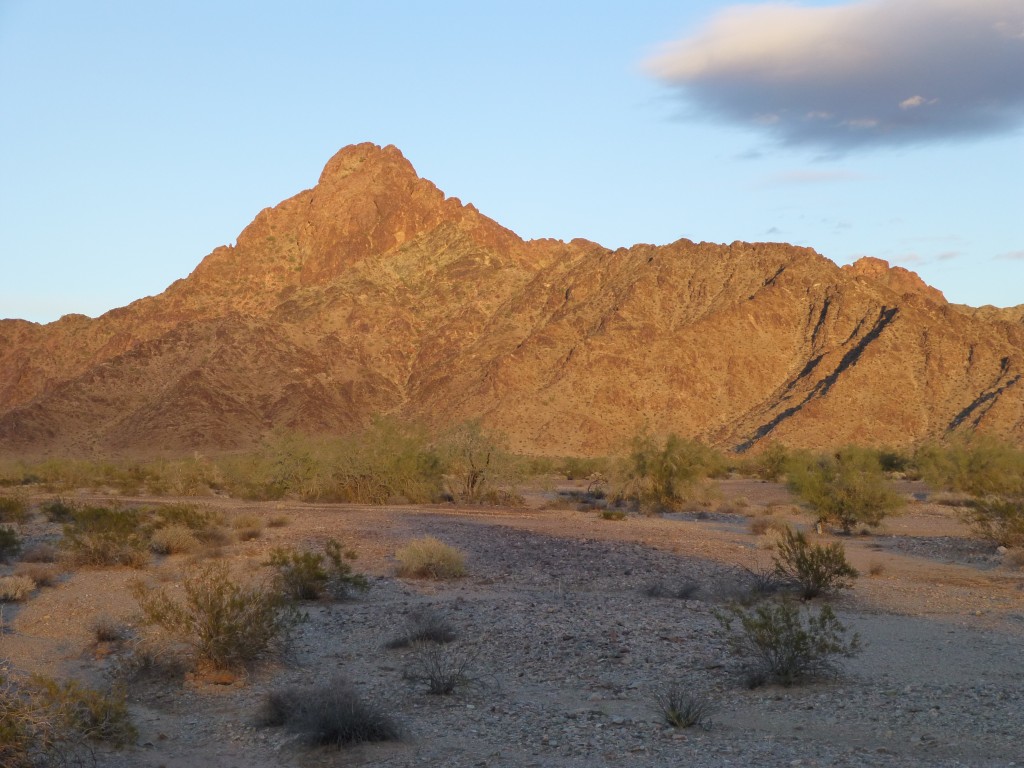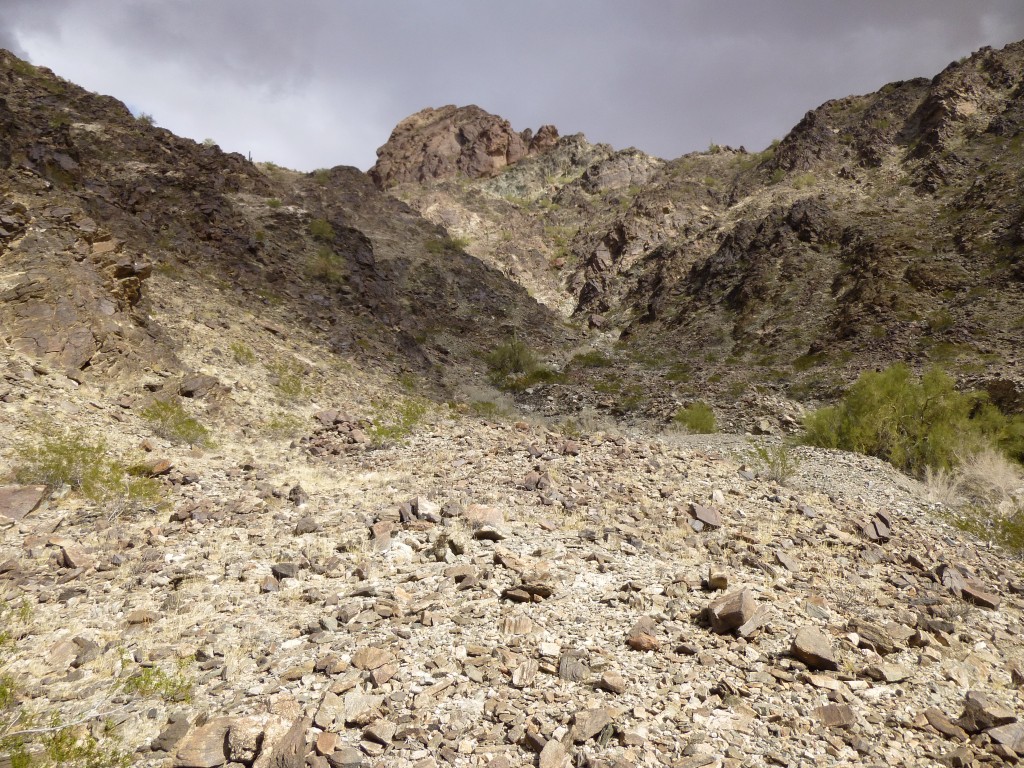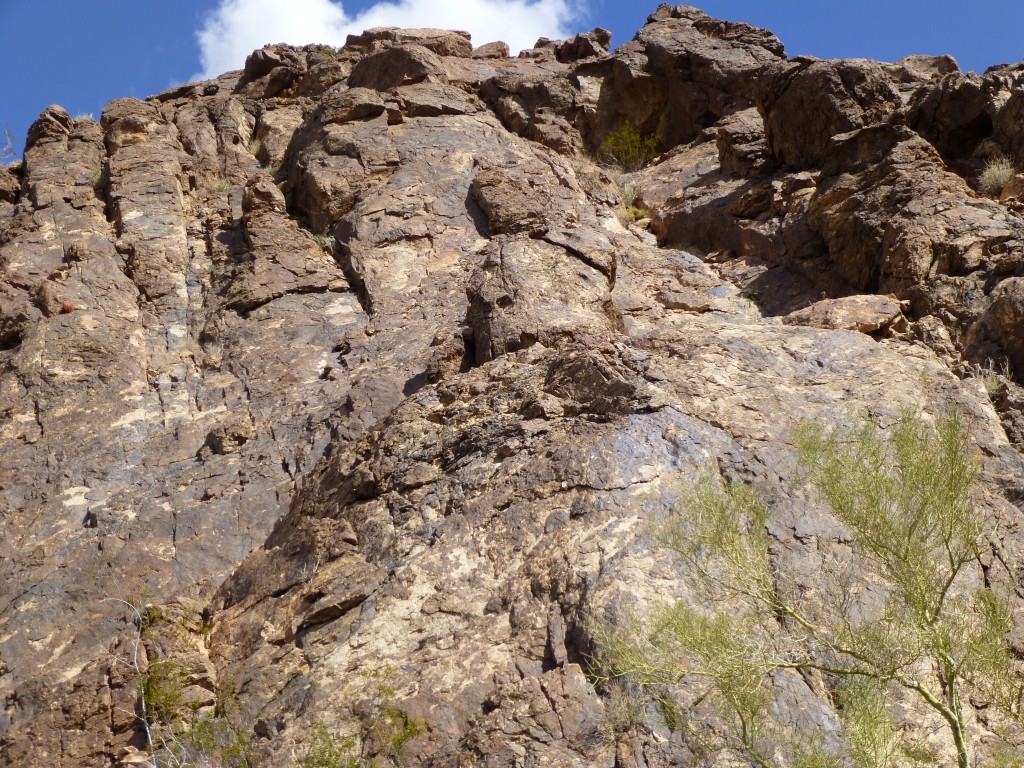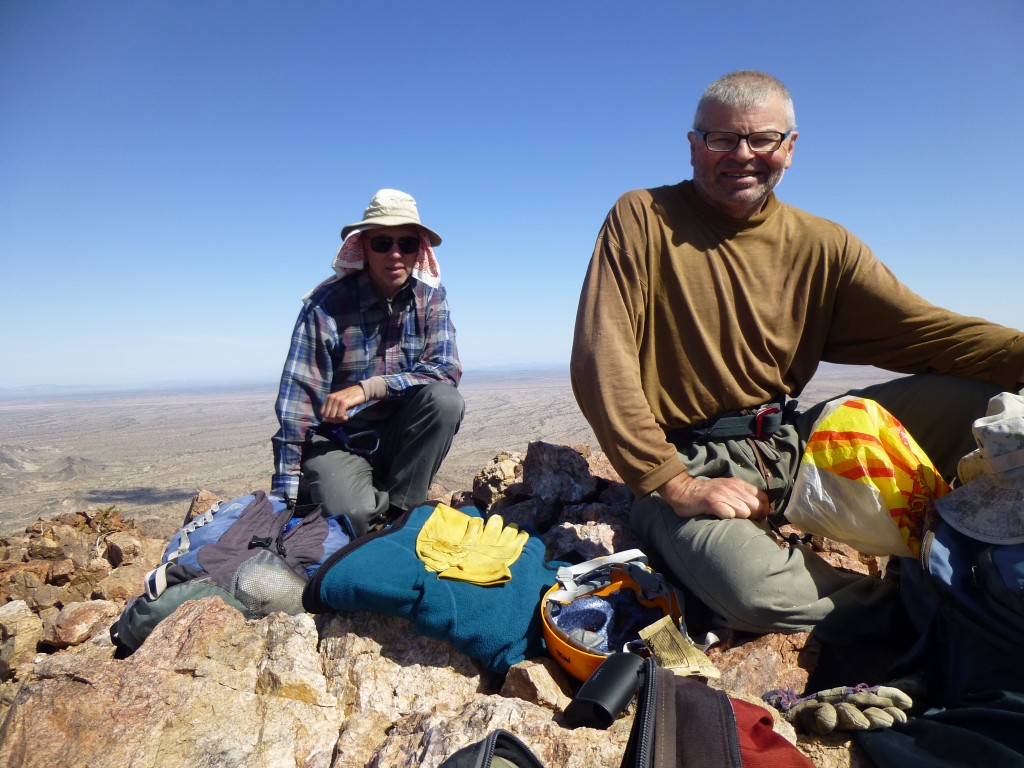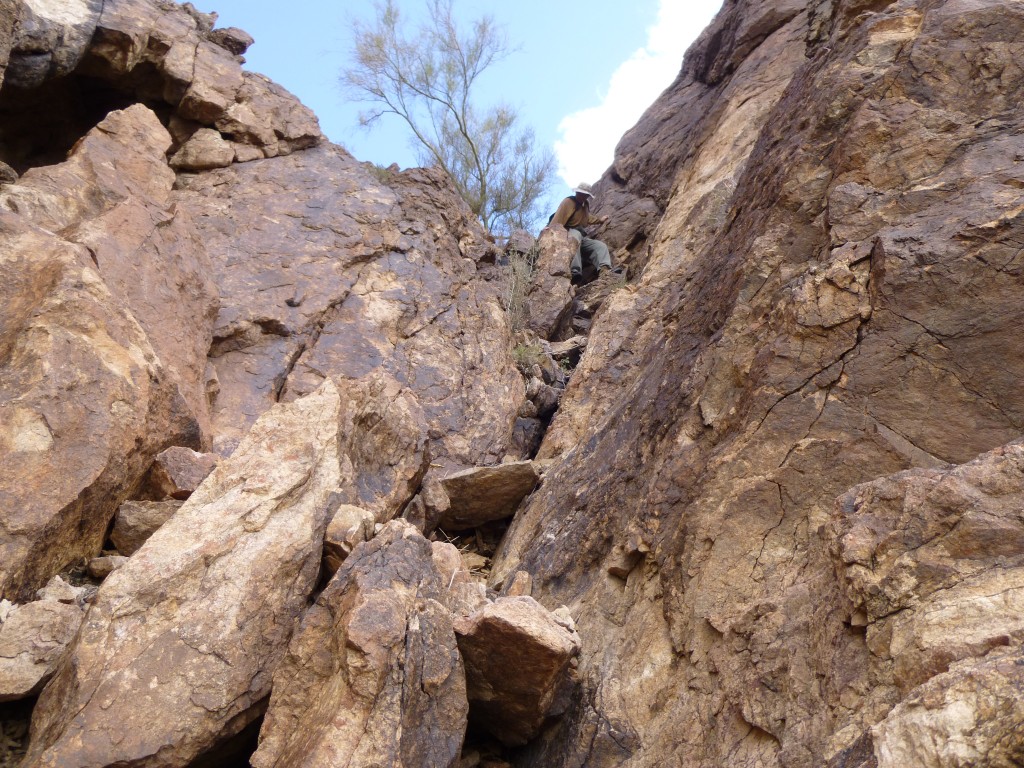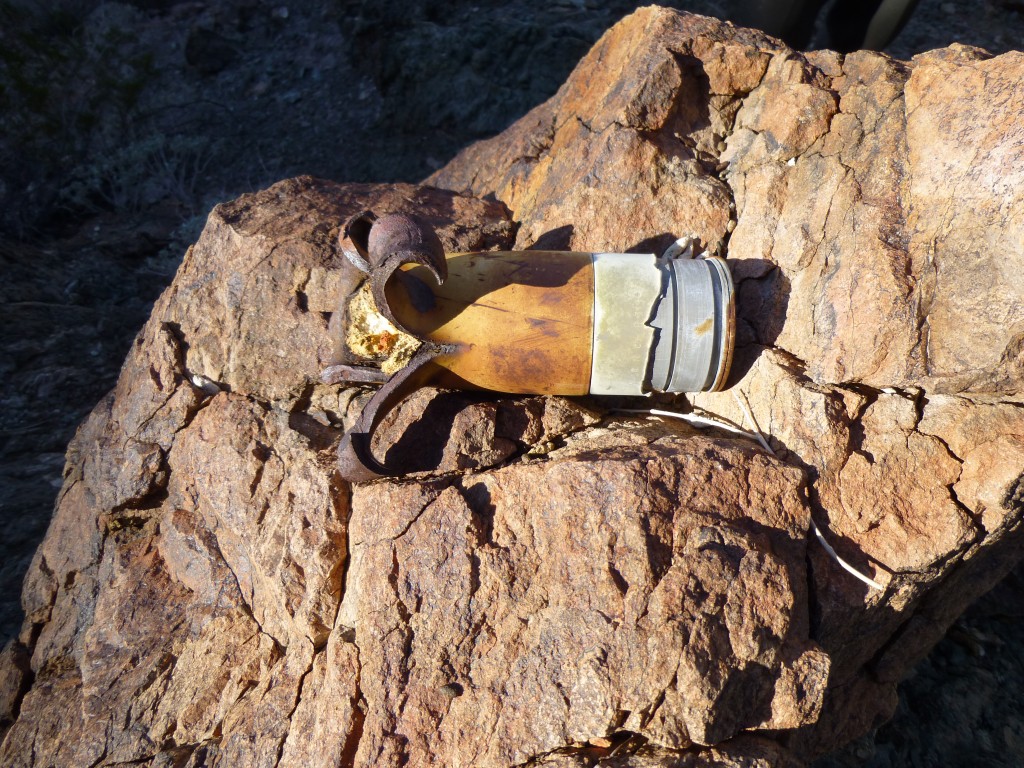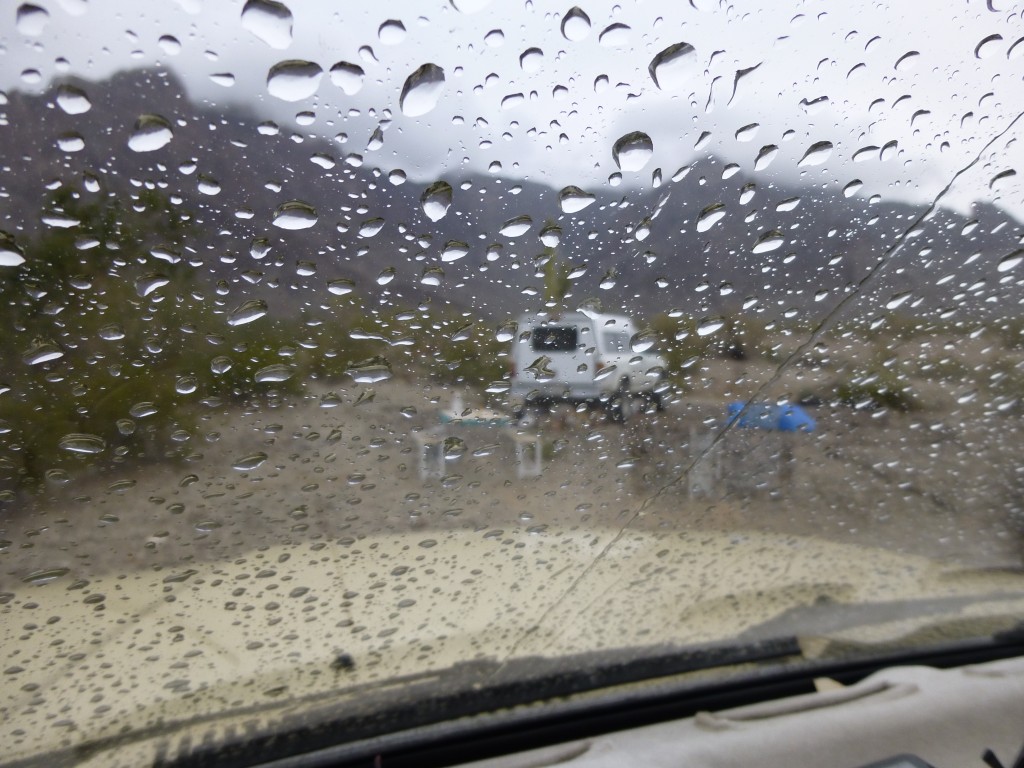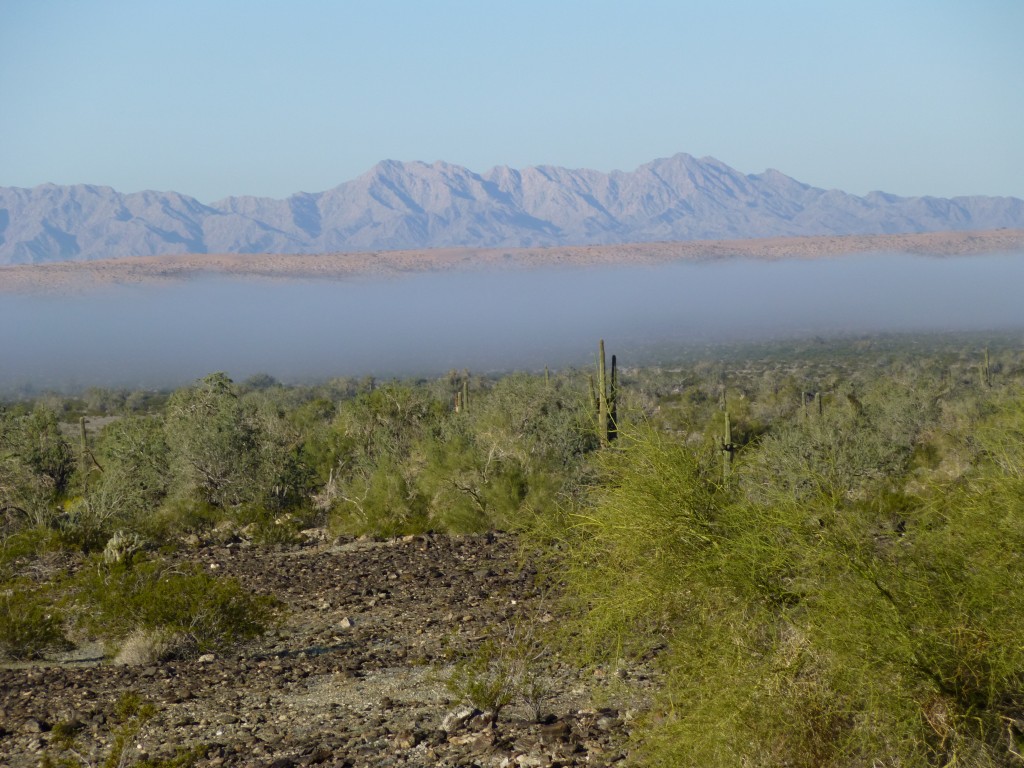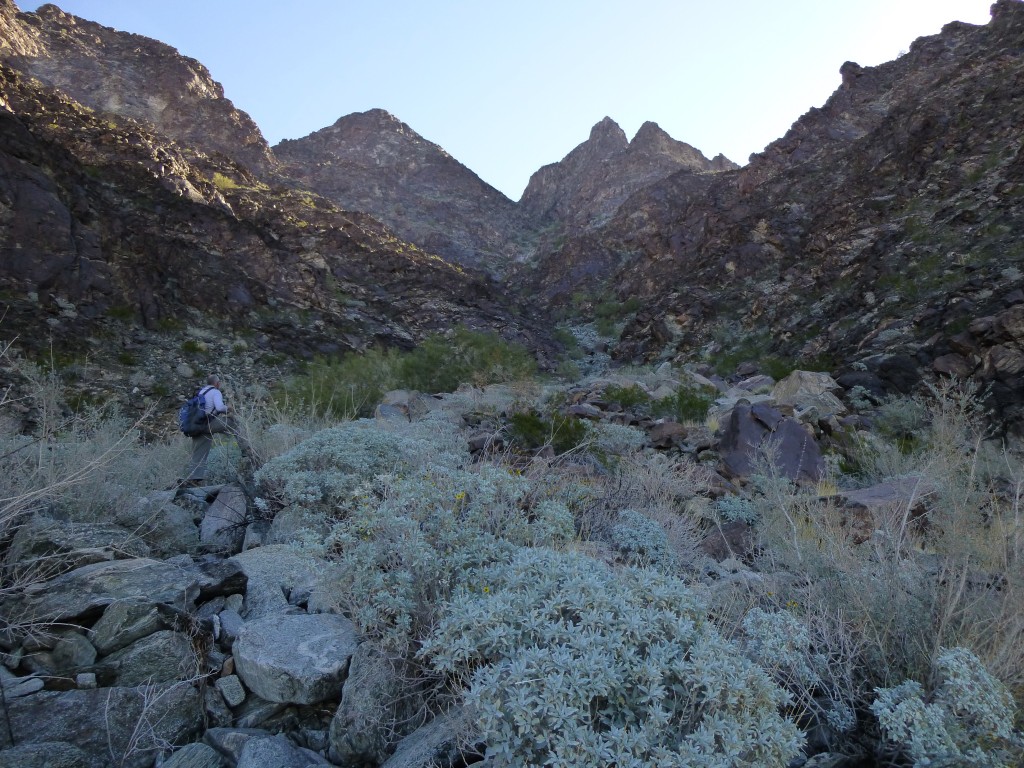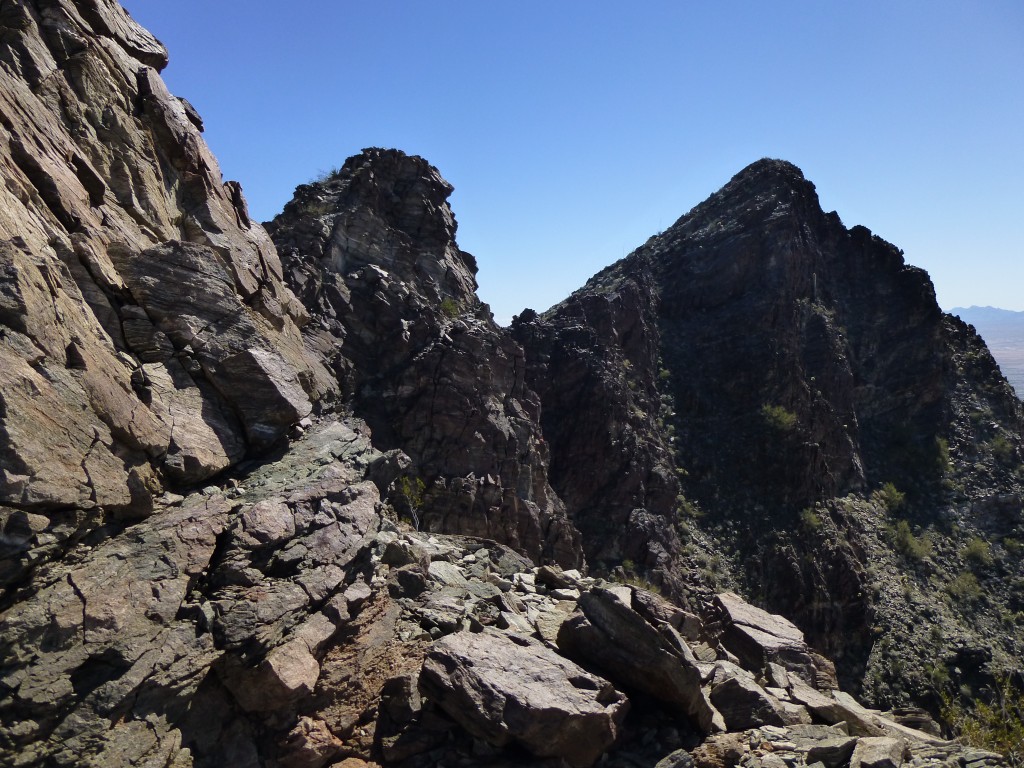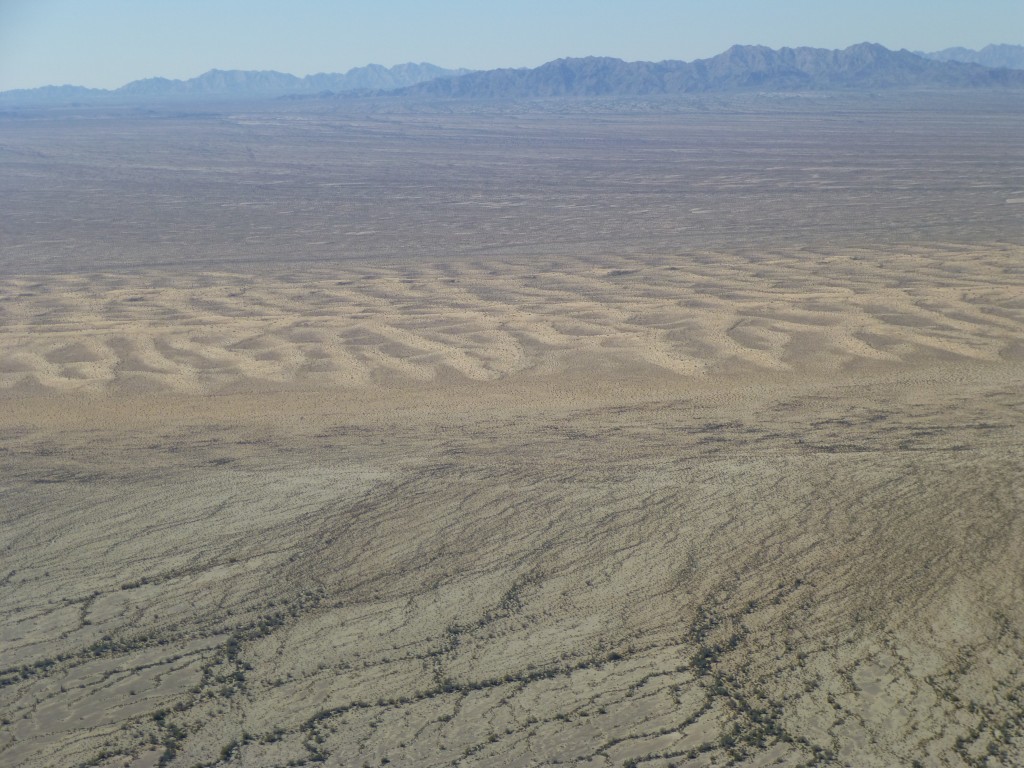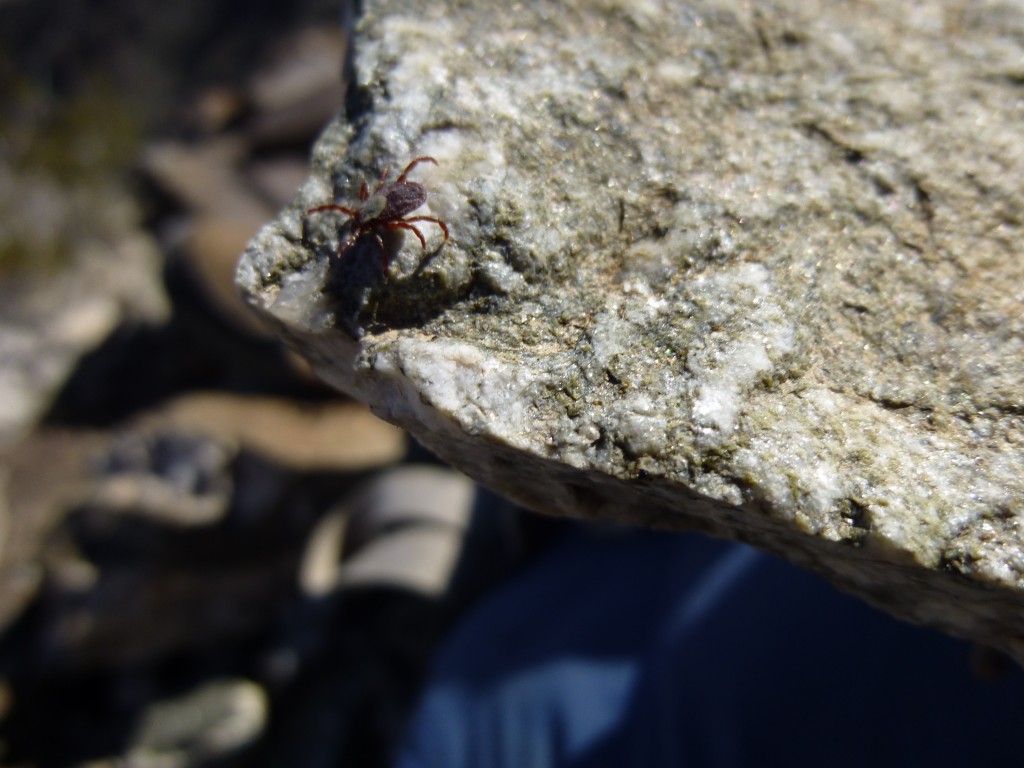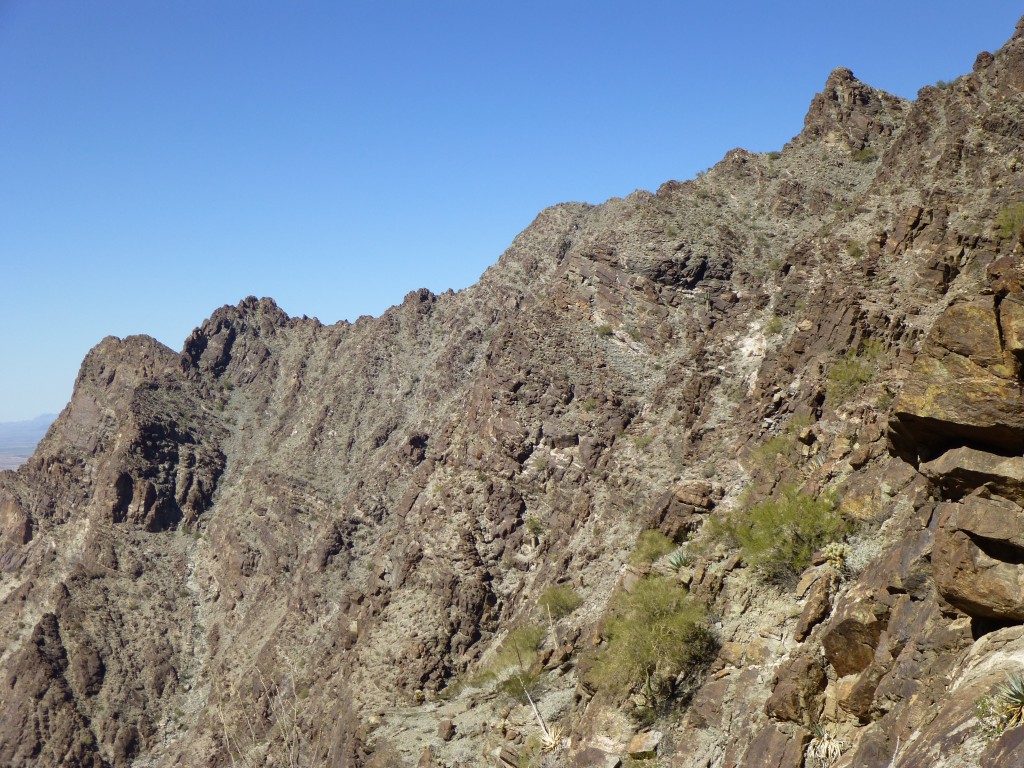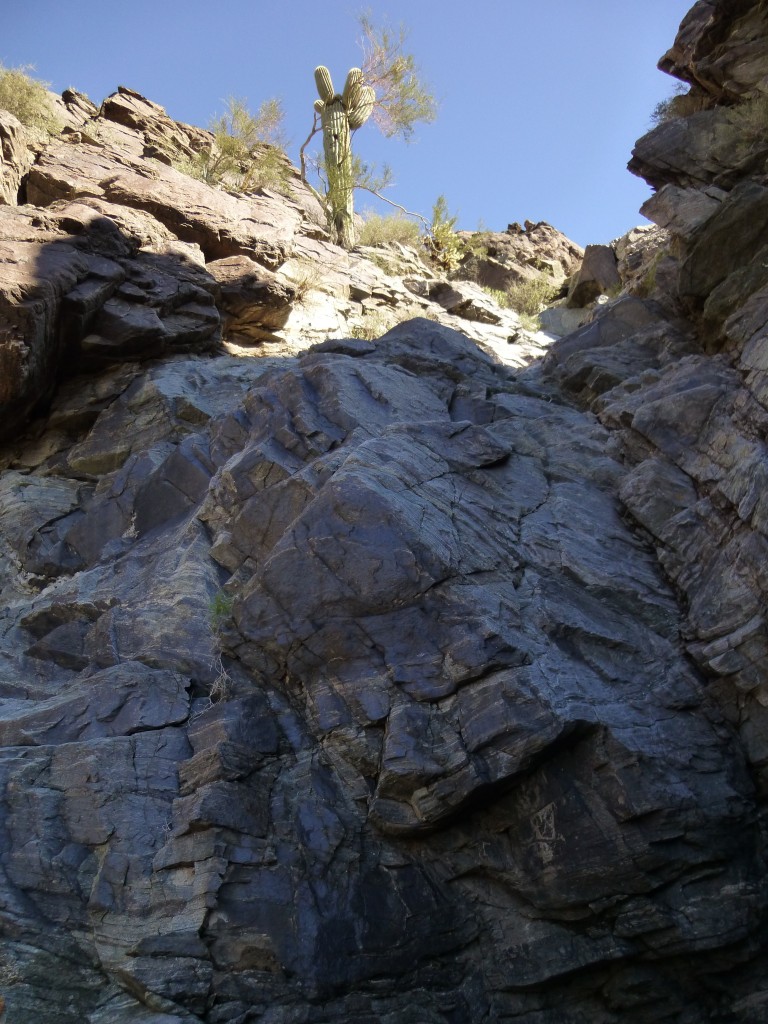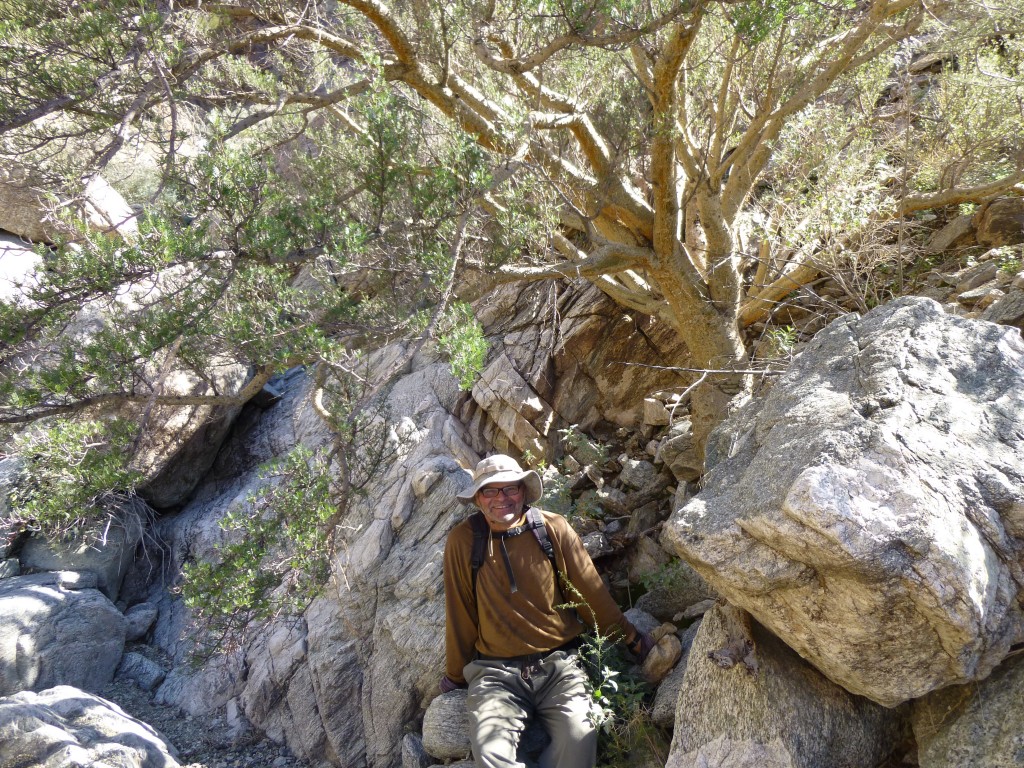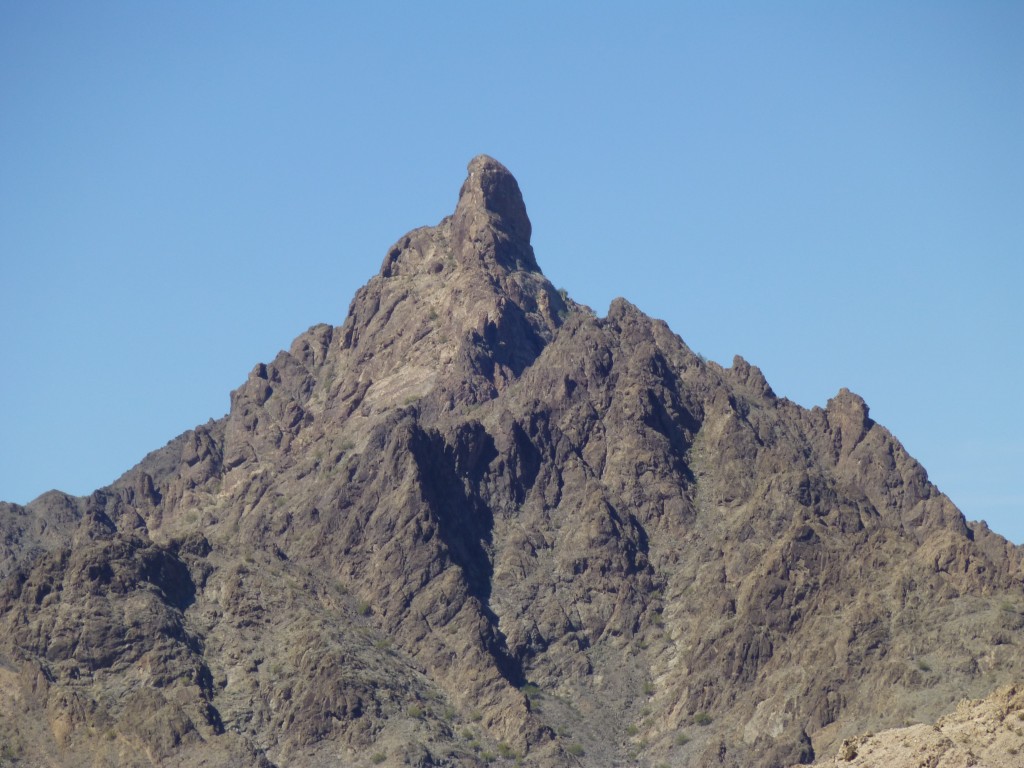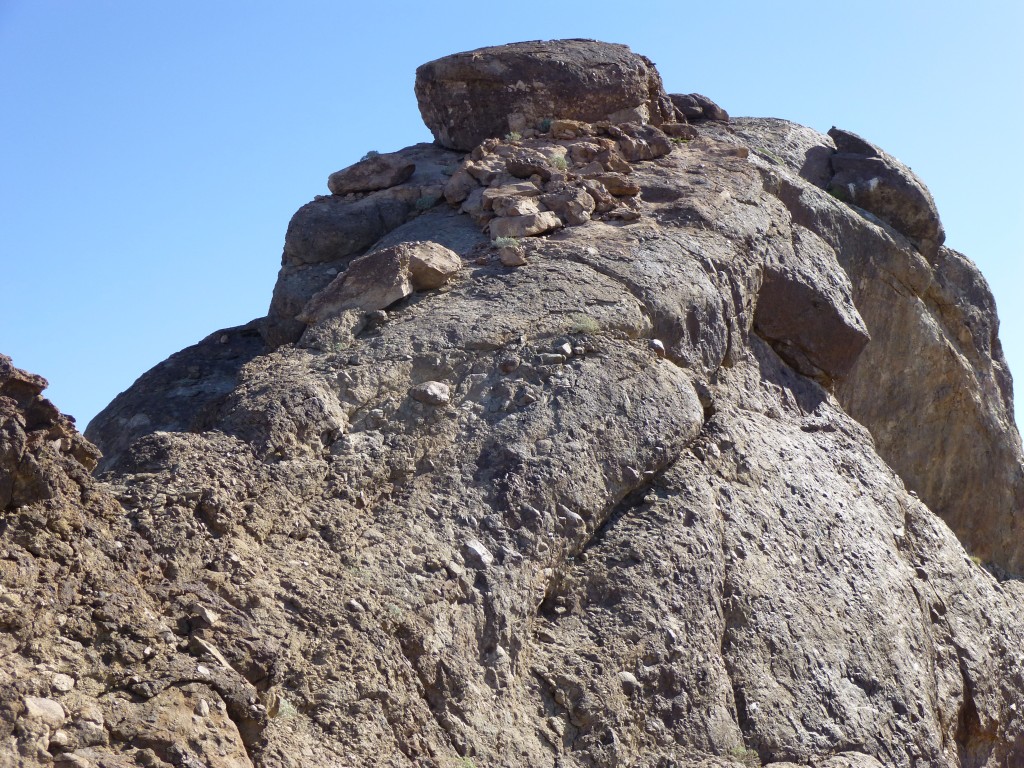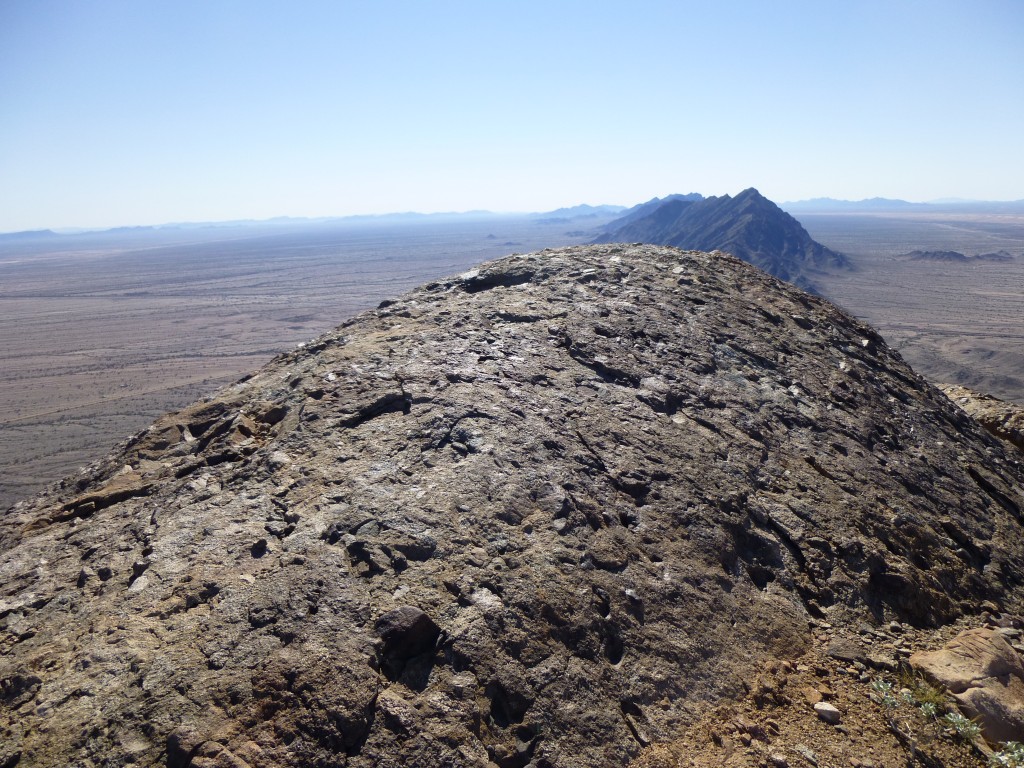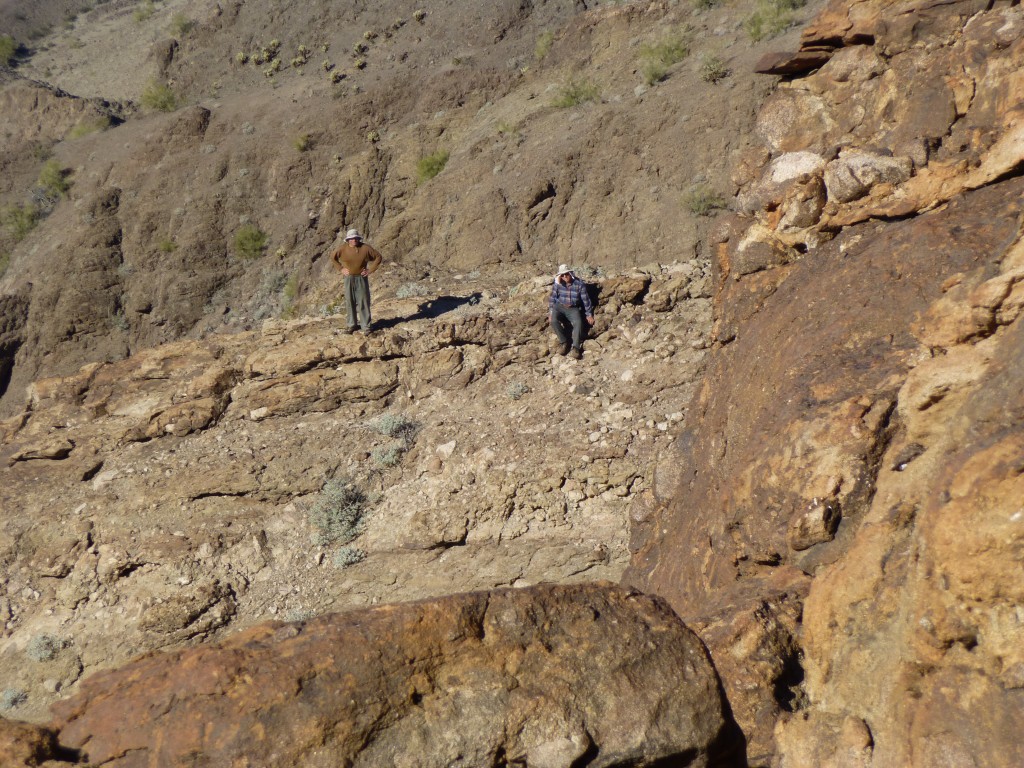On the evening of February the 20th, we arrived at the base of Peak 1894 in the Mohawk Mountains. I’ve never written about the Mohawks before, but they are an amazing range that has garnered my respect and admiration for thirty years. They occupy a corner of the Barry M. Goldwater bombing range in extreme southwestern Arizona and span 35 air miles from end to end. Steep, rugged, unforgiving. Friendly, they are not. You work hard for every one of them. Here is the first view we had that evening as we pulled up to Peak 1894.
During the last bit of daylight left to us, we glassed the slopes. Mark and RHiker had been here once before. Without any prior knowledge of the peak, they had figured out the only sensible way up the first three-quarters of it. We pondered the route above their high point, but couldn’t tell much from our position due to the angle and the fading light. Sitting around a campfire, I asked a lot of questions about how things looked above their high point, but talk can only get you so far – we had to have boots on the rock to really tell. They had stopped where they did because it looked pretty difficult. I have to admit that, when I turned in that night, I was concerned about how successful we might be tomorrow.
Our sixth day dawned crisp and clear. We were going to give it our best shot, so we all wore harnesses and carried a rope, slings and little else in the way of gear – oh yes, I brought my helmet too. We set out and aimed for a canyon on the southwest corner of the mountain. It didn’t take long to reach the base of the peak and then start the climb up to the steep rock.
We were able to gain a lot of elevation, maybe 700 vertical feet, on easier ground before arriving at the start of the tricky bits. A fifty-foot climb up a Class 3 notch brought us to the spot where the guys had stopped a few years before. There, we rested and studied what lay above us, but we couldn’t see very far up the route. It was steep, no doubt about it, but how was the rock and how tricky was the climbing?
I put on my helmet and decided to give it a go and walked over to the base of the steep part. The rock was pretty decent and there were plenty of holds, so up I went. After the first fifty feet or so, I settled in to wait at a good spot and hollered down to the guys to follow. They did, and we were soon huddled together to decide the next move. Hey, at least we were higher than their previous high point, right?. One chunk at a time, we made our way higher up the rib. Mark led some parts and I led others. It was a lot of Class 3, and some Class 4 climbing, steep and sustained. At one particularly exposed spot high up on the climb, I set up a belay for the guys. Beyond that, we soon topped out on the summit – a steep eyrie with mind-numbing drops on all sides. What a rush! The summit register bore the names of a few friends who had made it up before us, so we were in good company, a pretty elite group.
On the summit, we savored the moment.The guys finally had their peak, and I had overcome my concerns about how it might go. I’m always a little worried about down-climbing a steep peak like this one, so after maybe half an hour, tops, we started down. It didn’t take long to reach the spot where we had set up the belay, which we did again. Below that, we just each made our own way down – very slowly and carefully. Before too long, we were negotiating the last bit of Class 3 and could breathe a sigh of relief. Here is Mark on the last tricky bit.
Once the rock-climbing was done, we still had to descend to the desert floor. En route, we found this interesting-looking device laying on a rock. The thick metal was peeled back as easily as one would peel a banana. Stuff like this, littering the landscape, is why you sign a hold-harmless agreement with the military before you are allowed to go into these areas.
By the time we got back to the truck, 5 1/2 hours had passed, and we had our peak. It felt pretty good to have nailed this one. A few drops of rain fell as we headed back out to the “main road”. Kind of a misnomer for the so-called Mohawk-Papago Well Road between the sand dunes and the range itself – it was hard to drive more than five miles per hour on it, and it was bone-jarring. We covered a whopping seven miles before calling it a day, parking near our next peak, the second-highest in the range. Our plans for a fire and happy hour were dashed, however, as dark clouds rolled in from the west and the heavens opened. For a couple of hours, it really poured. All we could do was hunker down in the trucks and wait for it to pass. It did, but it was well after dark before we sounded the all-clear. Everything was soaked, so no fire tonight.
It was a chilly 38 degrees the next morning, and we had fog! A rare event in the desert. Here is a telephoto shot from our camp. Fog sits in the valley bottom, the light-brown sand dunes rear up above and the tops of the distant Cabeza Prieta Mountains are seen even higher.
Our goal today was Peak 2685, a worthy crag standing over 2,000 feet above camp. We set out across the desert and soon reached the mouth of a major canyon, the path we had chosen to reach the peak. The going was pretty good, with no major obstacles, until we came to a band of cliffs that stretched across our path. It gave us pause, and it took a while to negotiate a way up through the steep gritty rock. Once we were above it, we all agreed that coming back down that way was not appealing. Here is a view of our peak from lower in the canyon. The summit is the right-hand point of the double peak.
As we climbed, the visibility was limited – we could never see all that far ahead, but it kept going. Call us lucky. Mark hollered down to us that he had made it to the ridge. Once we caught him up, we saw this view ahead – it was obvious it wasn’t over yet.
It took a while, but we made it. The views from the top were amazing – I especially like this one of the sand dunes far below. These dunes are in a long band, as much as 2 1/2 miles wide and twenty miles long, and rise a full 200 feet above the desert floor. They are designated an Area of Critical Environmental Concern. The public is not allowed to enter within.
On the summit, here’s someone else we met – another tick! This thing was tiny, maybe an eighth of an inch across, and just like the others we had found before. Oh yeah, I forgot to mention that a few days earlier, Mark had seen one on my neck and pulled it off, which drew blood. I still wonder to this day if I became infected with something evil from that little rat-bastard!
We found a register and signed in. A few others had been there before us, including a couple who had come up the major canyon to the north of ours. Knowing their route had worked was all we needed to decide to go out that way rather than back down the way we had climbed in. The descent down the canyon was steep in spots but, bit by bit, we kept on going. Man, that canyon was big, fenced in by huge walls of mostly-rotten rock.
There were spots of steep rock which took some tricky downclimbing, but one by one we worked past them all.
A real treat we saw in a few places was an elephant tree. The Latin name is Bursera microphylla, and they are quite rare. They seem to only grow in the harshest areas of the desert where the rainfall is scant, only three inches a year in this case. A curious thing about them is the pungent odor that is released when you touch them. We saw perhaps ten of them in the two miles of canyon.
As we gained the lower reaches of the canyon, we had to make a decision as to which direction to head across the desert to reach the trucks. Good ol’ GPS to the rescue once again – it led us right to them, even though they were well-nigh impossible to spot amongst the vegetation. This little adventure had burned up more than seven hours, but what a great climb. Lots of challenges, plenty enough to have kept us on our toes all the live-long day.
After a couple of cold ones to soothe our parched throats, we headed north once again. Our idea was to get as much of this road under our belts as possible before we lost the light. We made it, crossing out of the bombing range after having flirted with the Mohawks for fifty miles. This night, our campsite was within a mile of the freeway and railroad, not at all the remoteness we had enjoyed up until now. But we were within easy striking distance of our next peak, our last but definitely not the least of the trip.
The next morning, luck was with us as we found an obscure wire gate which allowed us to pass through the fence and drive directly on to the freeway. I remembered it from almost thirty years earlier, and it saved us fifteen miles of driving to Tacna and back again. Our day was getting off to a good start. One more peak to do, and it was a doozy. With an elevation of 1,975 feet, Mohawk Peak stands high above its surroundings, so prominent that it has been used by travelers as a landmark for centuries. It can be easily seen from every direction for many miles, and today acts as a homing beacon for undocumented border-crossers as they brave the perils of the Lechuguilla Desert in the hope of a new life in the U.S.
We managed to drive pretty close to the peak, within a mile of the summit as the crow flies. It was another perfect day as we set out, and soon we were entering a steep rocky canyon. I remember a curious incident – as we rested in the shade of a huge boulder, a strange aircraft flew over. It had an odd shape, and made no sound that we could hear. No doubt about it, it was a military drone. We only saw if for a few moments as it passed high overhead, seen between narrow canyon walls.
In fine form, we quickly gained well over a thousand vertical feet, and stepped out on to the summit ridge. Now moving southeast, the crux of the climb came into view. Mark had been here years before and had soloed this thing. RHiker had also visited with friends and they had decided not to try the last bit. I was the only one of us that had never been here before. We stood at a critical point on the narrowing ridge, and it was time to climb or pack sand. Here is what we saw.
A narrow rock bridge, maybe three feet wide, led steeply up to an area of large rocks which were perched on the rounded ridge. You can see them in the above photo. Mark decided he didn’t want to try it again. RHiker also decided against it. I can’t blame them – as you stand at the start of the bridge, it is very intimidating. I realized that I too was talking myself out of it. Maybe what changed my mind was this – I was hot, sweaty and tired but didn’t want to come back again. Nothing to do but go for it. And I knew that the longer I deliberated, the greater the chance I would talk myself out of the whole thing. So, I left my pack with the guys and simply started climbing up.
It felt pretty secure clambering over the rocks until I reached that mother of all boulders seen in the above photo. The drop-off is mystifyingly steep, and as I worked my way around it on the right hand side I was ready to leave a load in my pants. There wasn’t anything to hang on to – all I could do was touch the side of the smooth boulder and make sure I didn’t slip. It all turned out okay. Once around the boulder, I continued up the spine of the ridge and soon emerged on the rounded summit. No sign of Hawk Benchmark which was supposed to be up there. No cairn, no register, no nothing. Balder than a billiard ball. Several others had climbed this thing, but had left no sign – maybe wind or lightning had blasted it all off.
I didn’t linger, nor did I leave a register. To say that I was nervous about retracing my steps was the understatement of the year. Here is a photo I took of the guys from the summit. It is a telephoto shot, so is foreshortened, but you can see the huge boulder at the bottom of the picture – the actual climbing route is all out of sight off the right side.
It all worked out, and I was soon back down with the guys. I was still nervous as a cat around a vacuum cleaner – all I wanted to do was sit down and drink a lot of water. We soon left and made our way back down the mountain without incident. By the time we reached the trucks, 3 1/2 hours had passed. We convoyed back out to the pavement and said our goodbyes. What a great trip it had been – 13 peaks in 8 days, and not a bad one in the bunch. This kind of trip reminds us why we are peakbaggers.
Please visit our Facebook page at https://www.facebook.com/pages/Desert-Mountaineer/192730747542690

